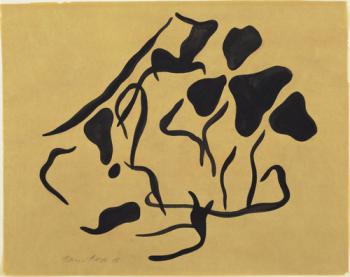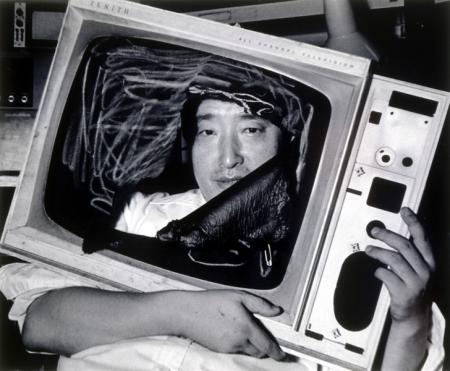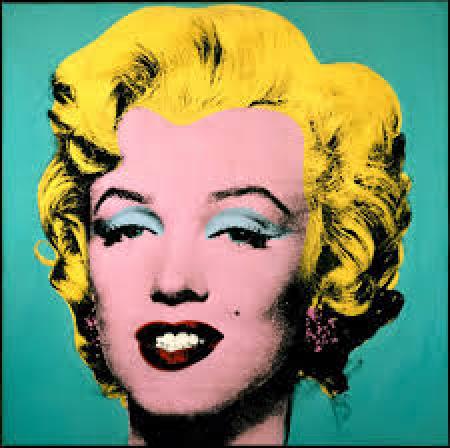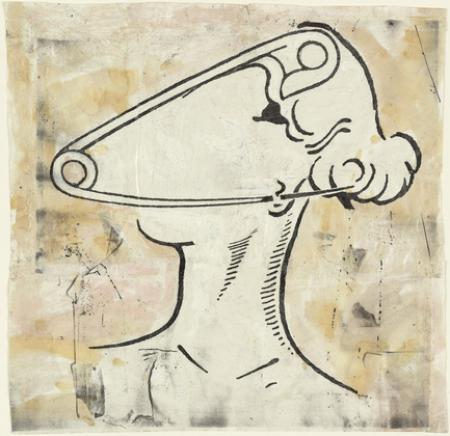Serendip is an independent site partnering with faculty at multiple colleges and universities around the world. Happy exploring!
Blogs

Automatism
Automatism is a type of art that comes from completely random thoughts. It can be written, drawn or painted and just means that the art was done in a sort of "spur-of-the-moment" type of way. Some artists believe that just letting themselves create without any plan they can reach a new level of creativity. The name "automatism" was appropriated by surrealists from physiology and refers to actions and processes that are involuntary and not under concious control. "Action painting" is a type of automatism art that Jackson Pollock regularly used.
For more information go to: http://www.moma.org/collection/theme.php?theme_id=10947
 Automatic Drawing by Jean (Hans) Arp
Automatic Drawing by Jean (Hans) Arp

Nam June Paik
 Nam June Paik used technology as an art form, and has often been called the godfather/grandfather/George Washington of video art.
Nam June Paik used technology as an art form, and has often been called the godfather/grandfather/George Washington of video art.
One of his exhibits was made of 52 TVs that were each covered by an aquarium filled with water and fish that swam around in front of what was appearing on the TVs. Another piece he did was "TV Buddha," in which a sculpture of a seated Bhudda who watched humself on a closed circuit television.
For more infomation, go to: http://articles.latimes.com/2006/jan/31/local/me-paik31

The guy and his cambell's cans.
Andy Warhol is known for taking play to the next level. He loved being bold and distinct and making his thoughts visual. His art represented his playfulness with the media and his choice of colors. Some of his art became contradicting, but to him it just meant being free and letting his take be known and that people were paying attention to his art and acknowledging it.


Innovating Pedagogy 2013: Learning from gaming
The Innovating Pedagogy report is an annual overview of edutech from the Institute of Educational Technology at the Open University. The 2013 report, the second in the series, selects 10 emerging innovations from the long list of existing technologies which the institute believes have the potential to make a significant impact on education. These are not technologies which are in development or even new, but rather technologies and ideas which are already being effected but have room to expand. The report ranks each innovation in terms of potential impact and timescale for implementation, describes its current application, and then explains the pedagogy behind the innovation and how it could be re-envisioned for maximum impact. The next innovation the report describes is learning from gaming.
Potential impact: high
Timescale: medium

Ten Minutes on Giacomo Balla
Giacomo Balla was a futurist painter who lived from 1897-1958. The futurist movement was one based on, frankly, movement, and the idea that paintings culd be more than static images. He and his contemporaries tried to express velocity in an object by using planes of color to realistically or abstractly create a work that was more than a still life. It was a very progressive movement that gave birth to thousands of painting and sculptures that challenged the idea that a motionless canvas must contain a motionless subject.

The Dynamism of a Dog on a Leash
http://uploads8.wikipaintings.org/images/giacomo-balla/dynamism-of-a-dog-on-a-leash-1912.jpg

The Street Light—Study of Light
http://uploads1.wikipaintings.org/images/giacomo-balla/street-light-1909.jpg
http://www.britannica.com/EBchecked/topic/50455/Giacomo-Balla
http://www.guggenheim.org/new-york/collections/collection-online/artists/bios/862

Innovating Pedagogy 2013: Geo-learning
The Innovating Pedagogy report is an annual overview of edutech from the Institute of Educational Technology at the Open University. The 2013 report, the second in the series, selects 10 emerging innovations from the long list of existing technologies which the institute believes have the potential to make a significant impact on education. These are not technologies which are in development or even new, but rather technologies and ideas which are already being effected but have room to expand. The report ranks each innovation in terms of potential impact and timescale for implementation, describes its current application, and then explains the pedagogy behind the innovation and how it could be re-envisioned for maximum impact. One of the innovations described is geo-learning.

Exquisite Corpse
The exquisite corpse was a parlor game in which people would work together to write a story. There were several versions of exquisite corpse each of which having different rules; for some, each person would write one word and then fold the paper so that the next person could not see the word they wrote. In other games, people would write lines, and cover half of the line before the next person began writing. The surrealist movement eventually adopted the exquisite corpse game. Surrealists worked together to create pieces of art that they believed were exploring the subconscious and collective unconscious.
On another note, I watched the movie "The Exquisite Corpse Project." It was much longer than the ten minutes we were supposed to spend doing research so I won't write about it. Check out the trailer if this sounds interesting to you, and if you watch the movie, I'd love to chat about it.
information: http://exquisitecorpse.com/definition/About.html
http://www.moma.org/visit/calendar/exhibitions/1256
image: http://www.moma.org/visit/calendar/exhibitions/1256


since you're all thinking about self-representation this week
...i thought you might be interested in (inspired/put off by?) this
animated version of Janis Joplan's final interview, on creativity and rejection....

Control+Shift+Terror
There are a few places where I want to take this paper. We’ll start briefly in a city: Philadelphia. And then we’ll go to another city: Nairobi. And then into some playful, less familiar, far less appealing, but ultimately unavoidable terrain -- simply due to the fact that the world has taken us into this direction and it would be foolish to ignore or underestimate its gravity and relevance in our everyday lives. Because, after all, with what are we left at the end of the day other than our everyday lives? It would, no doubt, serve us well to place our concerns in the big picture of a communal everyday life.
I haven’t yet gone to any markets in Philadelphia, but I know that there are some major, historically-significant markets around the city. I’ve heard they’re fun, cute, artsy - what have you - but I’ve been to my fair share of markets around the world so I don’t yet feel a particular urgency to see more. Markets can be many things (to those other than the sellers), but mainly they are a consumer’s form of entertainment and leisure, effectively through their engagement with a capitalist economy or market system. Producers and sellers make attractive their product or the experience of its purchase, thus encouraging active and enjoyable participation in the market - arguably, a form of play, be it consciously or otherwise.

Surrealist Games
Surrealism was started in Paris near the end of WWI, and despite much speculation to the contrary, has become an international movement and never quite vanished. It encompasses a vast variety of subversion and therefore defies much explanation.
Surrealist games often include the "irrational embellishment" of ideas or objects, as well as the irrational placement of several ideas or objects together. Surrealist poetry is often incomprehensible. The object of most of these games and poems seems to be to create something nonsensical out of sense.
http://www.surrealistmovement-usa.org/pages/forecast.html
http://www.purselipsquarejaw.org/surrealist_games/
http://www.artic.edu/aic/collections/exhibitions/Modern/resource/1049


